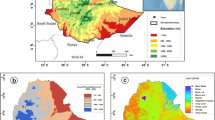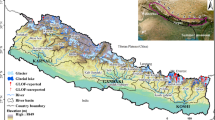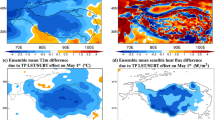Abstract
Glaciers in the Tomor region of Tianshan Mountains preserve vital water resources. However, these glaciers suffer from strong mass losses in the recent years because of global warming. From 2008 to 2009, a large-scale scientific expedition has been carried out in this region. As an individual reference glacier, the tongue area of Qingbingtan glacier No. 72 was measured by the high precise Real Time Kinematic-Global Position System (RTK-GPS). In this paper, changes of the tongue area of Qingbingtan glacier No.72 has been studied based on topographic map, remote sensing image and the survey during 2008#x2013;2009 field campaign. Results indicated that the ice surface-elevation of the tongue area changed — 0.22±0.14 m a−1 from 1964 to 2008. The estimated loss in ice volume was 0.014±0.009 km3, which represented a ∼20 % decrease from the 1964 volume and was equivalent to average annual mass balance of −0.20±0.12 m water equivalent for the tongue area during 1964–2008. Terminus retreated by 1852 m, approximately 41 m a−1, with the area reduction of 1.533 km2 (0.034 km2 a−1) from 1964 to 2009. Furthermore, the annual velocity reached to ∼70 m a−1. Comparing with the other monitored glaciers in the eastern Tianshan Mountains, Qingbingtan glacier No.72 experienced more intensive in shrinkage, which resulted from the combined effects of climate change and glacier dynamic, providing evidence of the response to climatic warming.
Similar content being viewed by others
References
Barry RG (2006) The status of research on glaciers and global glacier recession: a review. Progress in Physical Geography 30: 285–306.
Bauder A, Funk M, Huss M (2007) Ice-volume changes of selected glaciers in the Swiss Alps since the end of the 19th century. Annals of Glaciology 46: 145–149.
Bown F, Rivera A (2007) Climate changes and recent glacier behaviour in the Chilean Lake District. Global and Planetary Change 59: 79–86.
Climate and Environment in China (2006) China Meteorological Administration. Beijing: Science Press. (In Chinese)
Duval P (1977) The role of the water content on the creep rate of polycrystalline ice. In: IAHS Publ. 118 (Symposium at Grenoble 1975 — Isotopes and Impurities in Snow and Ice). pp 29–33.
Dyurgerov M (2002) Glacier mass balance and regime: data of measurements and analysis. Boulder, CO, University of Colorado. Institute of Arctic and Alpine Research. (INSTAAR Occasional Paper 55.)
Dyurgerov M (2003) Mountain and subpolar glaciers show an increase in sensitivity to climate warming and intensification of the water cycle. Journal of Hydrology 282(1–4): 164–176.
Haeberli W (1990) Glacier and permafrost signals of 20thcentury warming. Annals of Glaciology 14: 99–101.
Haeberli W, Hoelzle M, Paul F, et al. (2007) Integrated monitoring of mountain glaciers as key indicators of global climate change: the European Alps. Annals of Glaciology 46: 150–160.
Hoelzle M, Haeberli W, Dischl M, et al. (2003) Secular glacier mass balances derived from cumulative glacier length changes. Global and Planetary Change 36: 295–306.
Houghton JT and 7 others (2001) Climate change 2001: the scientific basis. Contribution of Working Group I to the Third Assessment Report of the Intergovernmental Panel on Climate Change. Cambridge: Cambridge University Press.
Huss M, Jouvert G, Farinotti D, et al. (2010) Future highmountain hydrology: a new parameterization of glacier retreat. Hydrology and Earth System Sciences 14: 815–829.
IPCC (2007) Climate Change 2007: Impacts, Adaptation, and Vulnerability. Summary for Policymakers. Report of Working Group II of the Intergovernmental Panel on Climate Change. Cambridge: Cambridge University Press.
Jing ZF, Ye BS, Jiao KQ, et al. (2002) Surface velocity on the Glacier No.51 at Haxilegen of the Kuytun River, Tianshan Mountains. Journal of Glaciology and Geocryology 24(5): 563–566. (In Chinese with English summary)
Kang ES, Cheng GD, Dong ZC (2002) Glacier-snow water resources and mountain runoff in arid area of northwest China. Beijing: Science Press. (In Chinese)
Kuhn M (1985) Fluctuations of climate and mass balance: different responses of two adjacent glaciers. Zeitschrift für Gletscherkunde und Glazialgeologie 21: 409–416. (In Germany)
Lanzhou Institute of Glaciology and Geocryology (LIGG) (1987) [Tianshan Mountains (interior drainage area of Tarim basin in southwest).] In Glacier inventory of China. Vol. III. Beijing: Science Press. Academia Sinica, Lanzhou Institute of Glaciology and Geocryology. (In Chinese)
Li ZQ (2005) A glacier melt water pool was discovered at summit of East Branch of Glacier No. 1 at Urumqi River head, Tianshan Mts., Xinjiang. Journal of Glaciology and Geocryology 27: 150–152. (In Chinese with English summary)
Li ZQ, Han TD, Jing ZF, et al. (2003) A summary of 40-year observed variation facts of climate and Glacier No.1 at headwater of Urumqi river, Tianshan, China. Journal of Glaciology and Geocryology 25(2): 117–123. (In Chinese with English summary)
Li ZQ, Li KM, Wang L (2010) Study on recent glacier changes and their impact on water resources in Xingjiang, North Western China. Quaternary Sciences 30(1): 96–106. (In Chinese with English summary)
Li ZQ, Shen YP, Li HL, et al. (2008) Response of the melting Urumqi Glacier No.1 in eastern Tianshan to climate change. Advances in Climate Change Research 4(Suppl.): 67–72.
Li ZQ, Wang FT, Zhu GC, et al. (2007) Basic features of the Miaoergou flat-topped glacier in east Tianshan Mountains and its thickness change over the past 24 years. Journal of Glaciology and Geocryology 29(1): 61–65.
Liu CH, Kang ES (1999) The research about glaciers change and runoff effect in the northwestern region of China. Science China Earth Sciences 29(Suppl. 1): 55–62. (In Chinese)
Liu SY, Sun WX, Shen YP, et al. (2003) Glacier changes since the Little Ice Age maximum in the western Qilian Shan, northwest China, and consequences of glacier runoff for water supply. Journal of Glaciology 49(164): 117–124.
Meier MF and 7 others (2007) Glaciers dominate eustatic sealevel rise in the 21st century. Science 317(5841): 1064–1067.
Molina C, Navarro FJ, Calvet J (2007) Hurd Peninsula glaciers, Livingston, Island, Antarctica, as indicators of regional warming: ice-volume changes during the period 1956–2000. Annals of Glaciology 46: 43–49.
Oerlemans J (1994) Quantifying global warming from the retreat of glaciers. Science 264: 243–245.
Oerlemans J, Fortuin JPE (1992) Sensitivity of glaciers and small ice caps to greenhouse warming. Science 258: 115–118.
Pelto MS, Hedlund C (2001) Terminus behavior and response time of North Cascade glaciers, Washington, U.S.A. Journal of Glaciology 47: 497–506.
Pu JC, Su Z, Yao TD, et al. (1998) Mass balance on Xiao Dongkemadi glacier and Hailuogou glacier. Journal of Glaciology and Geocryology 20(4): 408–412. (In Chinese with English summary)
Raymond C, Neumann TA, Rignot E, et al. (2005) Retreat of Glaciar Tyndall, Patagonia, over the last half-century. Journal of Glaciology 51(173): 239–247.
Richards JA (1993) Remote sensing digital image analysis: an introduction. Second edition. Berlin: Springer-Verlag.
Rignot E, Rivera A, Casassa G (2003) Contribution of the Patagonian icefields of South America to sea level rise. Science 302(5644): 434–437.
Rivera A, Lange H, Aravena J, et al. (1997) The 20th century advance of Glaciar Pio XI, Chilean Patagonia. Annals of Glaciology 24: 66–71.
Rivera A, Benham T, Casassa G, et al. (2007) Ice elevation and areal changes of glaciers from the Northern Patagonia Icefield, Chile. Global and Planetary Change 59: 126–137.
Shangguan DH, Liu SY, Ding YJ, et al. (2008) Thinning and retreat of Xiao Dongkemadi glacier, Tibetan Plateau, since 1993. Journal of Glaciology 54(188): 949–951.
Shi YF (2001) Estimation of the water resources affected by climatic warming and glacier shrinkage before 2050 in west China. Journal of Glaciology and Geocryology 23(4): 333–341. (In Chinese with English summary)
Shi YF, Liu CH, Wang ZT, et al. (2005) A concise China glacier inventory. Shanghai: Shanghai Science Popularization Press. (In Chinese)
Shi YF, Liu SY (2000) Estimation of the response of glaciers in China to the global warming in the 21st century. Chinese Science Bulletin 45(4): 668–672. (In Chinese)
Shi YF, Liu SY, Shangguan DH, et al. (2006) Peculiar phenomena regarding climate and glacial variations on the Tibetan Plateau. Annals of Glaciology 43: 106–110.
State Bureau of Surveying and Mapping (2007) Technical rules for producing digital products of 1:10 000 1:50 000 fundamental geographic information. Part 1: Digital line graphs (DLG), CH/T 1015.1-2007.
Su Z, Liu SY, Wang NL, et al. (1992) Recent fluctuations of glaciers in the Gongga mountains. Annals of Glaciology 16: 163–167.
Vanlooy JA, Forster RR (2008) Glacial changes of five southwest British Columbia icefields, Canada, mid-1980s to 1999. Journal of Glaciology 54(186): 469–478.
Wang JX, Wang J, Lu CP (2003) Problem of coordinate transformation between WGS-84 and BEIJING 54. Journal of Geodesy and Geodynamics 23(3): 70–73. (In Chinese with English summary)
Yao TD, Pu JC, Lu AX, et al. (2007) Recent glacial retreat and its impact on hydrological processes on the Tibetan Plateau, China, and surrounding regions. Arctic Antarctic and Alpine Research 39: 642–650.
Zhang Y, Koji F, Liu SY, et al. (2010) Multi-decadal ice-velocity and elevation changes of a monsoonal maritime glacier: Hailuogou glacier, China. Journal of Glaciology 56(195): 65–74.
Zhang YS, Yao TD (1998) The response of continental-type glaciers to climate change in China. Journal of Glaciology and Geocryology 20(1): 3–8. (In Chinese with English summary)
Author information
Authors and Affiliations
Corresponding author
Rights and permissions
About this article
Cite this article
Wang, P., Li, Z., Li, H. et al. Ice surface-elevation change and velocity of Qingbingtan glacier No.72 in the Tomor region, Tianshan Mountains, central Asia. J. Mt. Sci. 8, 855–864 (2011). https://doi.org/10.1007/s11629-011-1018-x
Received:
Accepted:
Published:
Issue Date:
DOI: https://doi.org/10.1007/s11629-011-1018-x




